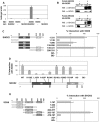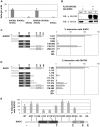NPPB and ACAN, two novel SHOX2 transcription targets implicated in skeletal development
- PMID: 24421874
- PMCID: PMC3885427
- DOI: 10.1371/journal.pone.0083104
NPPB and ACAN, two novel SHOX2 transcription targets implicated in skeletal development
Abstract
SHOX and SHOX2 transcription factors are highly homologous, with even identical homeodomains. Genetic alterations in SHOX result in two skeletal dysplasias; Léri-Weill dyschondrosteosis (LWD) and Langer mesomelic dysplasia (LMD), while no human genetic disease has been linked to date with SHOX2. SHOX2 is, though, involved in skeletal development, as shown by different knockout mice models. Due to the high homology between SHOX and SHOX2, and their functional redundancy during heart development, we postulated that SHOX2 might have the same transcriptional targets and cofactors as SHOX in limb development. We selected two SHOX transcription targets regulated by different mechanisms: 1) the natriuretic peptide precursor B gene (NPPB) involved in the endochondral ossification signalling and directly activated by SHOX; and 2) Aggrecan (ACAN), a major component of cartilage extracellular matrix, regulated by the cooperation of SHOX with the SOX trio (SOX5, SOX6 and SOX9) via the protein interaction between SOX5/SOX6 and SHOX. Using the luciferase assay we have demonstrated that SHOX2, like SHOX, regulates NPPB directly whilst activates ACAN via its cooperation with the SOX trio. Subsequently, we have identified and characterized the protein domains implicated in the SHOX2 dimerization and also its protein interaction with SOX5/SOX6 and SHOX using the yeast-two hybrid and co-immunoprecipitation assays. Immunohistochemistry of human fetal growth plates from different time points demonstrated that SHOX2 is coexpressed with SHOX and the members of the SOX trio. Despite these findings, no mutation was identified in SHOX2 in a cohort of 83 LWD patients with no known molecular defect, suggesting that SHOX2 alterations do not cause LWD. In conclusion, our work has identified the first cofactors and two new transcription targets of SHOX2 in limb development, and we hypothesize a time- and tissue-specific functional redundancy between SHOX and SHOX2.
Conflict of interest statement
Figures





Similar articles
-
SHOX interacts with the chondrogenic transcription factors SOX5 and SOX6 to activate the aggrecan enhancer.Hum Mol Genet. 2011 Apr 15;20(8):1547-59. doi: 10.1093/hmg/ddr032. Epub 2011 Jan 24. Hum Mol Genet. 2011. PMID: 21262861
-
Identification of a Gypsy SHOX mutation (p.A170P) in Léri-Weill dyschondrosteosis and Langer mesomelic dysplasia.Eur J Hum Genet. 2011 Dec;19(12):1218-25. doi: 10.1038/ejhg.2011.128. Epub 2011 Jun 29. Eur J Hum Genet. 2011. PMID: 21712857 Free PMC article.
-
Identification of the first recurrent PAR1 deletion in Léri-Weill dyschondrosteosis and idiopathic short stature reveals the presence of a novel SHOX enhancer.J Med Genet. 2012 Jul;49(7):442-50. doi: 10.1136/jmedgenet-2011-100678. J Med Genet. 2012. PMID: 22791839
-
Identification of 15 novel partial SHOX deletions and 13 partial duplications, and a review of the literature reveals intron 3 to be a hotspot region.J Hum Genet. 2017 Feb;62(2):229-234. doi: 10.1038/jhg.2016.113. Epub 2016 Sep 8. J Hum Genet. 2017. PMID: 27604558 Review.
-
[From gene to disease; from SHOX to Lèri-Weill dyschondrosteosis, Turner syndrome and idiopathic short stature].Ned Tijdschr Geneeskd. 2001 Jul 28;145(30):1456-9. Ned Tijdschr Geneeskd. 2001. PMID: 11503314 Review. Dutch.
Cited by
-
Identification and Tissue-Specific Characterization of Novel SHOX-Regulated Genes in Zebrafish Highlights SOX Family Members Among Other Genes.Front Genet. 2021 May 27;12:688808. doi: 10.3389/fgene.2021.688808. eCollection 2021. Front Genet. 2021. PMID: 34122528 Free PMC article.
-
A missense variant in the SOX5 gene (c.221C > T) is associated with intellectual disability.Orphanet J Rare Dis. 2025 Feb 4;20(1):50. doi: 10.1186/s13023-025-03548-z. Orphanet J Rare Dis. 2025. PMID: 39905544 Free PMC article.
-
Signaling pathways and clinical application of RASSF1A and SHOX2 in lung cancer.J Cancer Res Clin Oncol. 2020 Jun;146(6):1379-1393. doi: 10.1007/s00432-020-03188-9. Epub 2020 Apr 7. J Cancer Res Clin Oncol. 2020. PMID: 32266538 Free PMC article. Review.
-
The Short-Stature Homeobox-Containing Gene (shox/SHOX) Is Required for the Regulation of Cell Proliferation and Bone Differentiation in Zebrafish Embryo and Human Mesenchymal Stem Cells.Front Endocrinol (Lausanne). 2017 Jun 8;8:125. doi: 10.3389/fendo.2017.00125. eCollection 2017. Front Endocrinol (Lausanne). 2017. PMID: 28642734 Free PMC article.
-
Integrated transcriptomic analysis of human induced pluripotent stem cell-derived osteogenic differentiation reveals a regulatory role of KLF16.bioRxiv [Preprint]. 2025 Jan 27:2024.02.11.579844. doi: 10.1101/2024.02.11.579844. bioRxiv. 2025. PMID: 38405902 Free PMC article. Preprint.
References
-
- Rao E, Weiss B, Fukami M, Rump A, Niesler B, et al. (1997) Pseudoautosomal deletions encompassing a novel homeobox gene cause growth failure in idiopathic short stature and Turner syndrome. Nat Genet 16: 54–63. - PubMed
-
- Belin V, Cusin V, Viot G, Girlich D, Toutain A, et al. (1998) SHOX mutations in dyschondrosteosis (Leri-Weill syndrome). Nat Genet 19: 67–69. - PubMed
-
- Shears DJ, Vassal HJ, Goodman FR, Palmer RW, Reardon W, et al. (1998) Mutation and deletion of the pseudoautosomal gene SHOX cause Leri-Weill dyschondrosteosis. Nat Genet 19: 70–73. - PubMed
-
- Campos-Barros A, Benito-Sanz S, Ross JL, Zinn AR, Heath KE (2007) Compound heterozygosity of SHOX-encompassing and downstream PAR1 deletions results in Langer mesomelic dysplasia (LMD). Am J Med Genet A 143: 933–938. - PubMed
Publication types
MeSH terms
Substances
Supplementary concepts
LinkOut - more resources
Full Text Sources
Other Literature Sources
Molecular Biology Databases
Research Materials
Miscellaneous

